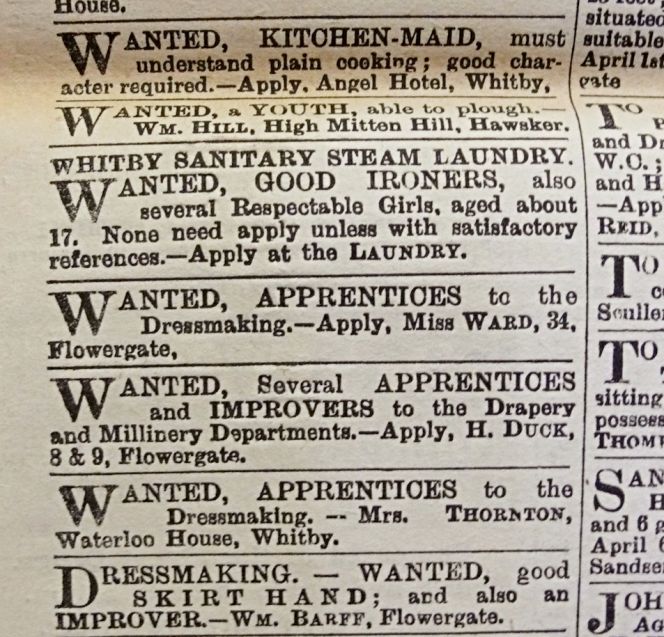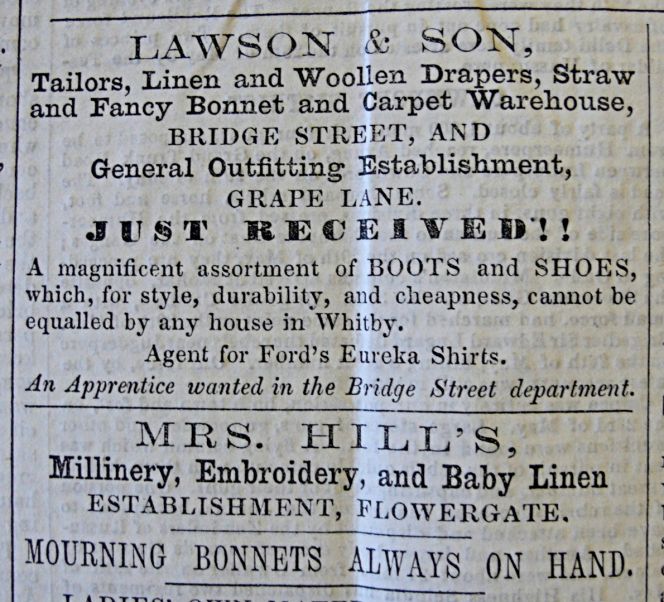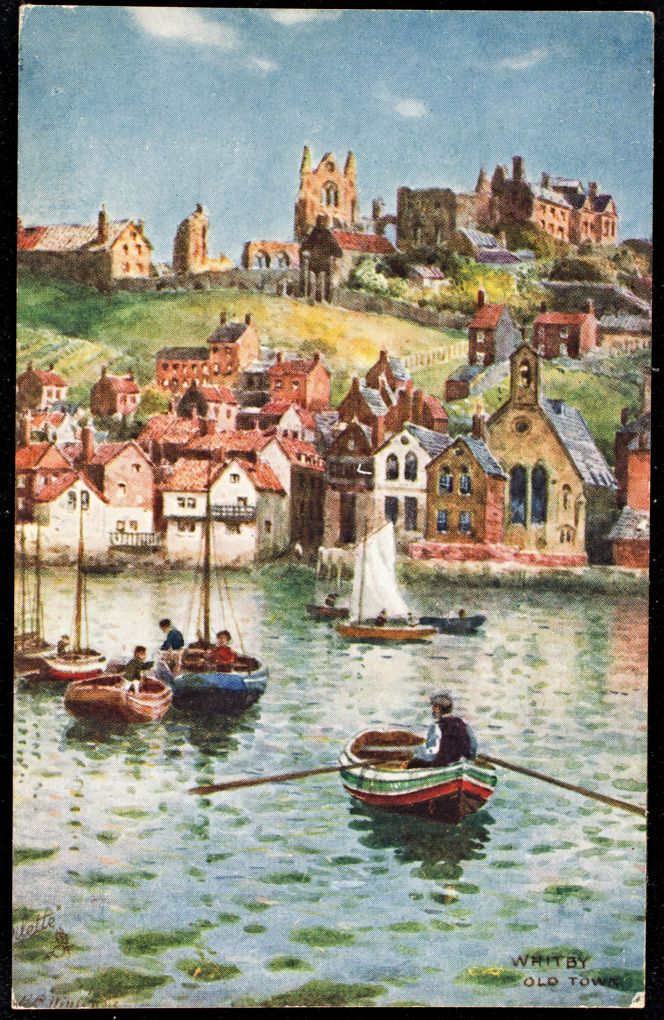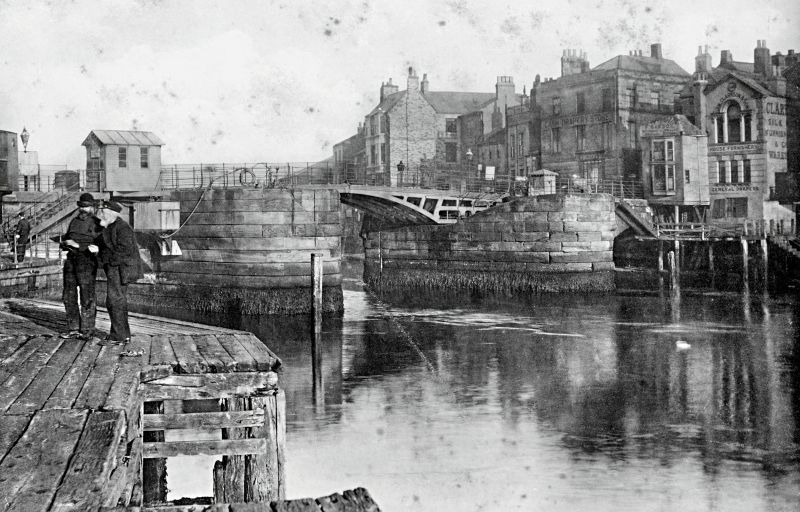ikfoundation.org
The IK Foundation
Promoting Natural & Cultural History
Since 1988


 Crowdfunding Campaign
Crowdfunding Campaignkeep knowledge open, connected, and growing on this textile history resource...
ADVERTISERS LOOKING FOR EMPLOYEES
– a Textile Study of Whitby Gazette from 1855 to 1914
Businesses searching for new employees began placing advertisements in the Whitby Gazette as early as the 1850s, often in special ‘situations vacant’ announcements that filled long columns or, more seldom, as an addition to an advertisement for a particular firm’s products. Usually, this would be an attempt to recruit one or two apprentices, whom the advertiser hoped would be able to start work at once or as soon as possible. Often, the same advertisement reappears for several successive weeks, so it may be supposed that finding suitable people to fill the new positions was not always easy. It was not often specified whether men or women were wanted, but presumably, this was usually clearly understood. Women were needed for dress or mantle-making and as sewing maids or milliners, while drapers and tailors looked for male apprentices. This essay will examine a selection of such advertising more closely.
 Whitby Gazette, April to June 1905. A method of advertising for employees common in style since the late 1850s. (Collection: Whitby Museum, Library & Archive). Photo: Viveka Hansen, The IK Foundation.
Whitby Gazette, April to June 1905. A method of advertising for employees common in style since the late 1850s. (Collection: Whitby Museum, Library & Archive). Photo: Viveka Hansen, The IK Foundation.By no means did all businesses use Gazette advertisements to find apprentices. However, some businesses, both large and small, did advertise for staff in this way, while others presumably simply placed notices in their shop windows. A good example of an advertisement combining information on goods offered for sale with vacancies for staff can be found in an announcement from Lawson & Son, who advertised in July 1858 for ‘An apprentice wanted in the Bridge Street department’, illustrated below. In this case, no details were given about the kind of work involved, though usually this would be specified. Another announcement from the same week reads, ‘Wanted immediately. Apprentices and Improvers to the Mantle and Dressmaking Business. Apply at the Gazette Office.’ The advertiser’s name was not given. Yet another advertisement that same week did specify both the nature and place of work. ‘Miss Thompson Milliner, Dress, & Mantle Maker, Skinner Street Whitby. Rooms at Mrs. Stevens’. Wanted immediately two Apprentices to Dressmaking’. In spring, two years later, Miss Thompson was again in need of apprentices but gave no exact work description, while Misses Noble & Wilson stated ‘Apprentices wanted’ for their millinery business in Baxtergate.
 Whitby Gazette 3 July 1858, Lawson & Son advertised for ‘An Apprentice wanted in the Bridge Street department’. (Collection: Whitby Museum, Library & Archive). Photo: Viveka Hansen, The IK Foundation.
Whitby Gazette 3 July 1858, Lawson & Son advertised for ‘An Apprentice wanted in the Bridge Street department’. (Collection: Whitby Museum, Library & Archive). Photo: Viveka Hansen, The IK Foundation.Among other advertisements that year was a position suitable for a young man: ‘Wanted, a respectable, well-educated Youth, about 15 years of age, as an Apprentice to the Drapery trade. – Apply to Mr. William Frankland, Church Street, Whitby.’ In 1865, the Wellburn Brothers of Bridge Street made several appeals for workers. One example was: ‘Wanted, a Machine hand for Dress and Mantle Making’, that is to say, someone adept at sewing clothes on that still relatively new invention, the sewing machine. The same year, Wilson & Skelton also advertised for ‘Apprentices to their Dressmaking and Millinery departments’, while Miss Dawson of Grape Lane had a similar requirement. A rather more unusual kind of apprentice was one sought in the spring of 1865 for work just outside Whitby: ‘An apprentice wanted to the Fellmongering and Leather-dressing Business – Apply to S. Braim & Sons, Briggswath’. This would have been heavy and dirty work intended for a young man who wanted to learn the trade.
To judge from an advertisement placed by the Tailor and Draper John Farrow in 1870: ‘Wanted, A Tailor, one who understands a Sewing Machine preferred.’ It could not yet be assumed that everyone in the tailoring and dressmaking trade knew how to use one of these machines. James N. Clarkson & Son were among the busier seekers after apprentices in this period. They had vacancies for dressmakers in 1870, 1875, and 1880; within spring 1875, an exceptional number of people were required: ‘James N. Clarkson & Son, have vacancies for Six Apprentices to the Dressmaking.’ Wellburn Brothers, on the other hand, needed makers of men’s clothes, and in spring 1870, they advertised: ‘To Tailors. Wanted, good Coat Hands. Also an Apprentice.’ But ten years later they appealed for ‘Dressmaking. Wanted immediately. Apprentices and Improvers’, which was, in any case, the most typical work description in such advertisements.
-664x517.jpg) Whitby Gazette, April to June 1880, ‘Wanted Apprentices...’. (Collection: Whitby Museum, Library & Archive). Photo: Viveka Hansen, The IK Foundation.
Whitby Gazette, April to June 1880, ‘Wanted Apprentices...’. (Collection: Whitby Museum, Library & Archive). Photo: Viveka Hansen, The IK Foundation.
Among others looking for Dressmakers’ Apprentices were W. Frankland & Son in 1875, Mrs Thornton in 1880 and Miss Campion in 1885. Sometimes, seamstresses were required to combine Dressmaking with Mantle-making, as with Miss Chapman in 1875 and Mrs Lowe in 1880 and 1885. The Misses Stangoe needed apprentices for their millinery business in 1880. The same year, General Draper H.C. Pulman advertised for ‘Apprentices and Improvers Wanted in the Dressmaking and Millinery Departments.’ A more unusual advertisement was inserted that year by Mrs Dawson of Raglan Terrace, who wanted seamstresses skilled in both hand and machine sewing to sew underclothes for ladies, gentlemen and children.
 It was not uncommon in these advertisements to seek servants able to work both in and out of doors but it was unusual to expect a general servant also to be professionally competent at sewing. One example was found in the spring of 1885: ‘Wanted, a Sewing Maid, and to assist in the housework. – Apply to the Housekeeper, The Abbey, Whitby.’ That is to say, Abbey House, situated beside Whitby Abbey – the imposing building illustrated on this postcard dated 1908, in the top left corner. (Courtesy: Leonard A. Lauder Collection of Raphael Tuck & Sons postcards, 7773. Public Domain.
It was not uncommon in these advertisements to seek servants able to work both in and out of doors but it was unusual to expect a general servant also to be professionally competent at sewing. One example was found in the spring of 1885: ‘Wanted, a Sewing Maid, and to assist in the housework. – Apply to the Housekeeper, The Abbey, Whitby.’ That is to say, Abbey House, situated beside Whitby Abbey – the imposing building illustrated on this postcard dated 1908, in the top left corner. (Courtesy: Leonard A. Lauder Collection of Raphael Tuck & Sons postcards, 7773. Public Domain. ‘The Bridge’, with several of Bridge Street’s drapery shops visible to the right, circa 1900, who regularly advertised during this period, among them James N. Clarkson & Son, described below. (Courtesy: Whitby Museum, Photographic Collection, Mammoth Postcard, B 295).
‘The Bridge’, with several of Bridge Street’s drapery shops visible to the right, circa 1900, who regularly advertised during this period, among them James N. Clarkson & Son, described below. (Courtesy: Whitby Museum, Photographic Collection, Mammoth Postcard, B 295). The most significant number of advertisements for workers during the period 1890 to 1914 involved the making of women’s clothes, which, for the most part, were still sewn locally. Men’s clothes were also sewn locally, but with every passing year, more and more ready-made trousers, jackets, overcoats and waistcoats were bought by the traders of Whitby from Leeds and other parts of West Yorkshire. If male apprentices were required, these would most often be for General Drapery, that is to say, for the most part, to sell ready-made clothes, accessories and cloth. This can be seen both in James N. Clarkson & Son’s 1895 advertisement: ‘Wanted, a well-educated Youth as Apprentice to the General Drapery’, and in 1900 with similar wording by the Wellburn Brothers. Both these well-established Whitby firms also advertised for dressmakers in the 1890s, while Wellburn Brothers repeatedly appealed for ‘Improvers, Experienced Bodice hands, Good Coat and General hands’. These advertisements continued into the new century up until 1914 when what was most required was ‘Dressmaking – Wanted, Apprentices and Bodice Hands’. Wellburn Brothers also advertised for a strong youth to work as an ‘Errand Boy’ the same year.
Other businesses looking for ‘Apprentices to the dressmaking’ included a number of the town’s female employers. Among those advertising were Miss Roberts of Esk Terrace 1895-1900, Mrs Thornton of Flowergate 1895-1914, Miss Beadnell of Silver Street (later on Skinner Street) 1900-1910 and Miss Ward of Flowergate 1905. Several other firms with more mixed requirements from their prospective employees advertised in 1905, among them Wm. Barff of Flowergate: ‘Dressmaking. Wanted, good Skirt Hand; and also an Improver.’, and H. Duck in the same street: ‘Wanted, Several Apprentices and Improvers to the Drapery and Millinery Departments, and Duck again in spring 1914: ‘Wanted Apprentices to the Drapery and Millinery Work-room’.
During this period, a new kind of hunting for workers was seen when people from outside Whitby began to advertise in the Whitby Gazette. Spring 1890 saw two examples from addresses in Stockton and Warrington. One was for female workers including Laundresses ‘wanting good Situations and Wages for all parts please apply Miss Wright, Derby House, Stockton’. The other was for a young man: ‘Drapery. Wanted, a respectable and well-educated Youth as an Apprentice to the Drapery Business. Apply, Robt Dobson, Draper, Warrington’. Similar advertisements from beyond Whitby appeared in spring 1914, for instance, from Marshall & Snelgrove in Scarborough: ‘Wanted, smart Youth as Apprentice to Drapery’ while Wiley in Pickering advertised for ‘Tailors wanted, at once, two good Men, used to ladies’ and gent’s trade’.
-800x576.jpg) One of the long-lived businesses that have not been able to be traced via advertisements for employees in the researched period up to 1914. Geo Hooper & Son’s establishment was founded in 1878 and survived till the 1970s, photo at unknown date. (Courtesy: Whitby Museum, Photographic Collection, Dor. 31-16).
One of the long-lived businesses that have not been able to be traced via advertisements for employees in the researched period up to 1914. Geo Hooper & Son’s establishment was founded in 1878 and survived till the 1970s, photo at unknown date. (Courtesy: Whitby Museum, Photographic Collection, Dor. 31-16).Another novelty in 1895 was a search for ‘Apprentices (for one year) to the Scientific Dressmaking’ at 29 Gray Street. The advertisement does not make clear who the owner of this business was. Still, the word “Scientific” indicates a new method of measuring, estimating, cutting and sewing clothes that were intended to be more flexible for the customer without requiring so many fittings. This resulted in something closer to factory-made dresses, though without the finesse and perfection to be expected of tailor-made garments.
Staff were also needed at the Steam Laundry at 30 Flowergate between 1900 and 1914. An advertisement in spring 1905 read, ‘Wanted, at once, good Washer-Woman; several good Ironers; also some respectable Girls, aged about 17 years. None need to apply unless with satisfactory references.’ In June 1914, it was made clear that applicants should not be below a certain age: ‘Wanted, Plain Ironers, not under 18.’ During 1910-1914, Mrs Thornton often advertised for ‘Apprentices for the Dress and Mantle making’, and on 22 May 1914, for a ‘Junior Assistant for shop sales. The vacant places advertised that week were many, as they usually were, but only one out of 62 had anything to do with the textile trade. The great majority of places advertised were for service staff, frequently defined as ‘General’ or ‘General Servant’, ‘Parlour-Maid’, ‘Cook-General’, ‘Gardener’ etc.
Sources:
- Adburgham, Alison, Shops and Shopping 1800-1914, London 1967.
- Hansen, Viveka, The Textile History of Whitby 1700-1914 – A lively coastal town between the North Sea and North York Moors, London & Whitby 2015. (pp. 116-119).
- Masset, Claire, Department Stores, London 2010.
- Whitby Museum, Library and Archive & Photographic Collections, Whitby Lit. & Phil. (In-depth research: original papers of Whitby Gazette 1855-1911 & the photographic collection).
More in Books & Art:
Essays
The iTEXTILIS is a division of The IK Workshop Society – a global and unique forum for all those interested in Natural & Cultural History.
Open Access Essays by Textile Historian Viveka Hansen
Textile historian Viveka Hansen offers a collection of open-access essays, published under Creative Commons licenses and freely available to all. These essays weave together her latest research, previously published monographs, and earlier projects dating back to the late 1980s. Some essays include rare archival material — originally published in other languages — now translated into English for the first time. These texts reveal little-known aspects of textile history, previously accessible mainly to audiences in Northern Europe. Hansen’s work spans a rich range of topics: the global textile trade, material culture, cloth manufacturing, fashion history, natural dyeing techniques, and the fascinating world of early travelling naturalists — notably the “Linnaean network” — all examined through a global historical lens.
Help secure the future of open access at iTEXTILIS essays! Your donation will keep knowledge open, connected, and growing on this textile history resource.
been copied to your clipboard




– a truly European organisation since 1988
Legal issues | Forget me | and much more...
You are welcome to use the information and knowledge from
The IK Workshop Society, as long as you follow a few simple rules.
LEARN MORE & I AGREE







